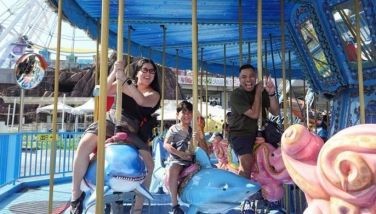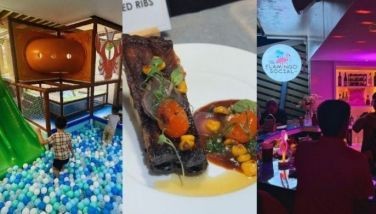Finding Filipiniana
One of the things I look forward to when I visit the United States, apart from seeing family, is picking up a small trove of treasures (to me, that is — junk to most others) that I would have accumulated over the preceding months at my sister’s place in Virginia. Typically, these would be old pens and watches I got off eBay in the US, often for next to nothing. I’m coming home this week with a few pretty baubles to add to the collection, and my friends can look forward to some showing and telling in the days ahead.
But there’s been another collecting area that I’ve been dabbling in and should really pay more attention to — old books and documents about the Philippines, many of which are just lying and moldering out there with very few people knowing what they are. This interest of mine in recovering Filipiniana began two decades ago when I was a graduate student in the American Midwest, where I stumbled across the odd book celebrating America’s acquisition of a new territory in the Pacific (such as Murat Halstead’s The Story of the Philippines and Our New Possessions) or a literary journal with a Filipino author among the contributors. I picked these up for a dollar or so, and over time I had a shelf full of them back in Manila, worthy of some academic paper in the future, and certainly of immediate reading.
Sometimes I don’t even keep them. As I’ve mentioned here before, one such favorite find was a copy of Story — America’s premier prewar fiction journal — from 1936, featuring Sinai Hamada’s classic short story, “Tanabata’s Wife.” I spotted it in a stack of papers in the basement of Milwaukee’s fabled five-story Renaissance Book Shop, whose floors, even in 1990, were already tilting to one side. Hamada’s publication in the US was an important breakthrough for Filipino authors at that time (just as interestingly, he had been preceded the month before by another Filipino, Manuel Arguilla). I bought the copy, brought it home, and presented it to the Baguio-based Hamadas, whom I knew.
Another wonderful discovery, this time a local one, was the first edition of Carlos Bulosan’s epic semi-autobiography, America Is in the Heart, which I acquired over a table at the Philcoa Jollibee after some negotiation with its owner. It had been personally inscribed by Bulosan to his friend, the future Chief Justice Fred Ruiz Castro. When our only daughter Demi married her Filipino-American boyfriend Jerry in the US four years ago, it became our wedding gift. (In a remarkable and totally unexpected twist, I found another another early edition of the same book on my desk upon my return — the personal copy of Greg Brillantes, which he had bought as a young man, and which he was gifting me with, having learned what I had done with mine.)
In Virginia last week, I collected five more old books and magazines, sourced over eBay from as far away as England. Underscoring my interest in Bulosan, two of them have to do with him.
A Bantam paperback edition of The Laughter of My Father (1946) shows Bulosan as most of his readers knew him, a folk humorist. As the back cover blurb puts it: “The first of Carlos Bulosan’s wonderfully funny stories about his father appeared in The New Yorker, and readers knew at once that a new and highly gifted humorist had been discovered. Bulosan has published other stories in Town and Country and Harper’s Bazaar. The Laughter of My Father is a worthy addition to the Bantam series of humorous books, which includes James Thurber’s Men, Women and Dogs and Sally Benson’s Meet Me in St. Louis.”
Bulosan, it seemed, was the toast of the town in 1946, when America Is in the Heart was published by Harcourt Brace. On March 9 that year, the Saturday Review of Literature published a review of the book — and put a now-iconic illustration of Bulosan’s portrait by Frances O’Brien Garfield on the cover (strangely enough, her name was misspelled as “Francis” on the issue credits, and continues to be misspelled in subsequent references). The review by William S. Lynch, titled “Loyalty in Spite of All,” noted that “It is a book of violence, written, however, with restraint and with the understanding that it is fear rather than inherent evil which prompts men to wickedness. It is a book, incidentally, which should make Americans ashamed of themselves.”
At about that same time, another Pinoy expat espousing a rather different aesthetic was also making waves. I picked up a copy of the May 1949 issue of the London-based Horizon, edited by Cyril Connolly, which featured a brash young poet named Jose Garcia Villa. Villa introduced his suite of seven “comma” poems (among them the much-anthologized “The,bright,Centipede”) thus:
“The reader of the following poems may be perplexed and puzzled at my use of the comma: it is a new, special and poetic use to which I have put it. The commas appear in the poems functionally, and thus not for eccentricity; and they are there also poetically, that is to say, not in their prose function…. The method may be compared to Seurat’s architectonic and measured pointillism…. Only the uninitiate would complain that Seurat should have painted in strokes.”
Two more items completed my trove. I have a small sub-collection of books on what we call the Filipino-American War, and the newest addition to that row will be Neely’s Photographs: Fighting in the Philippines, published in 1899, just a year after the Americans annexed the islands. Books like this were designed to give the folks back home in Nebraska and Wisconsin some idea of where their boys where and what they were doing. To me, fascinated by images of old Manila, and more than the many pictures of war and destruction in the book, the lost city in the background of Neely’s Photographs returns me to our irrecoverable past.
The last acquisition was something of a whim: a children’s book by Lucy Fitch Perkins titled The Filipino Twins, part of a popular series (The Dutch Twins, The Irish Twins, etc.) written by the author in the 1910s and 1920s. Perkins had visited Ellis Island, and her encounter with the world’s “oppressed and depressed,” as she put it, made her wonder what she could do to help the peoples of the world understand each other better. She later wrote: “I felt the necessity for this in this country where all the nations of the earth are represented in the population. It was at about this time that the expression ‘the melting pot’ became familiar as descriptive of America’s function in the world’s progress. The other idea was that a really big theme may be comprehended by children if it is presented in a way that holds their interest and engages their sympathies.”
Despite a few false notes (the family carabao is named Bobtail, the dog Dingo), the book seems impressively well researched, as if it had been written by someone who had visited the Philippines (as far as we can tell, she didn’t). “It was a busy place,” she wrote about a dock along the Pasig River. “Men were unloading fish and vegetables from other boats…. Other men were piling the produce on carts drawn by carabaos and hurrying away to the markets. Scores of boats were tied along the banks, and in and out and up and down the waterway busy tugs plied back and forth, filling the air with the screams of their whistles and with smoke from their stacks…. There were also ships just sailing away loaded with sugar, tobacco, lumber, hemp, and coconuts.”
Most of these books and magazines will eventually end up with the University of the Philippines library, save for a few that Demi might want to keep. I might yet come around to writing that paper about how other people saw us in their literature, but for now, finding them and bringing them home is excitement and reward enough for me.
* * *
E-mail me at penmanila@yahoo.com and check out my blog at www.penmanila.ph.




















